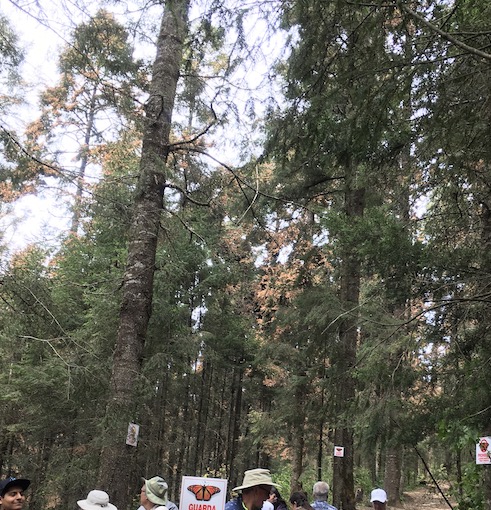
My wife Pat and I take our holidays in Mexico in January to miss some of the grey days and some of the alternating snow, ice, slush cycles of January in Toronto. This year we had resolved to tag a few days onto the end of our January month in the sun to go to the beautiful old Mexican town of Morelia and to take a day tour to see the Monarch butterflies in one of their wintering grounds in pine forests on the top of hills. We went to El Rosario. A warning - this story comes with some politics and an encouragement to visit the Monarch butterfly sanctuary.
The Monarchs are more than a beautiful butterfly. They are a pollinator. Greenpeace has tips on how you can help them in your garden. But their story is linked to both the US and to Mexico. And our story is about the Mexican end – in El Rosario Sanctuary in the state of Michoacan. The Monarch butterflies migrate from Texas to these hilltop pine forests in October and fly back in March. There is a first generation in Texas that then flies North. We get the second or third generation in Ontario before our generation starts the return trip. The last “super” generation of the year, which lives longer than the other generations – through the winter -- flies from Texas back to the forest winter sanctuaries in the high hills of Michoacan.
We chatted with the guide in the tour van because we knew that two deaths associated with El Rosario sanctuary had been reported in the Canadian press around two weeks before our visit. Our guide regretted the news. Two large tour buses had cancelled their visits to El Rosario. The butterfly tourism is important to El Rosario locals as well as the tour guides. This is a poor area. Our guide tried to tell us alternative news – a drunken party and the activist for the butterflies fell into the well where he was eventually found. It seems there is a problem of illegal cutting of the timber in the protected forest - and not just bits of firewood that some of the locals use for cooking. Our guide himself had seen several trucks loaded with lumber – the big pines – waiting to go out. He told us that the police manage to be on some other urgent project when the trucks leave.
Michoacan is also an area in which there are indigenous people and indigenous languages in use going back to the arrival of the Spanish. There is a rich history in the area in which the church and religious orders of the day played a positive role with the indigenous communities - inspired by Utopia - and got into trouble with the Spanish settlers. Today, some of these indigenous communities have kicked all the Mexican authorities from their forest land and they patrol it themselves to keep the timber poachers away. We were told they practice sustainable forestry. But this is another story.
So the politics is that the butterflies need visits. Tourists are not vulnerable. Locals earn some funds providing inexpensive horse rides up the steep slopes to the butterfly zone near the top. They also sell a nice lunch! And of course there are crafts and souvenirs. When we visit we are providing a kind of accompaniment for the guides and those looking after the butterflies. And they are looked after. The forest has to be preserved over the whole year and not just when the butterflies are there – November to March.
What about the butterflies? As the tour van climbed up the road out of the nearby mining town, we drove through fluttering butterflies looking for flowers with nectar to feed on. We arrived at a parking lot and entrance Kiosk some way up the hill. There is a well-marked trail that begins with 610 steps, and a separate horse trail. I confess that I went up on horseback with Pat. It was my first and last horseback ride, hanging nervously onto the saddle the whole way. I walked down! The last 200 meter walk to the butterflies is well marked and guides are with every group. There are signs calling for quiet as the zone is neared. There are yellow tapes warning where not to go and when to go no nearer. Yes, it is spectacular. Butterflies flutter all around. Clumps hang on the pine tree branches. They are dotting the sky above the tall trees. They land on a woman’s hat and she poses for pictures. You cannot capture this in a photograph. They are not just where you look, they are around. At the same time, Pat notes that there a sense of fragility to it all. It is not a whole forest. It is a chosen area. It is not every tree. And more than 50% of the world’s monarchs typically come to El Rosario. There are only one or two smaller wintering sites nearby.
So early next February, why
not enjoy a trip to this corner of Mexico
with good food, attractive colonial cities
and a special place in the history of North
America? Give yourself a treat and give a
bit of solidarity to our Mexican friends who
share protecting the monarch butterflies
with us.
